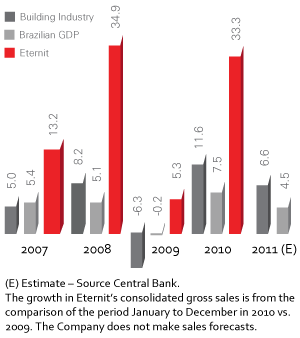03PLATFORM FOR THE NEXT 70 YEARS
SECTOR ANALYSIS
Chrysotile ore is used in more than 150 countries as a raw material for hundreds of industrial products, which include friction materials, textiles, sealing compounds and fibre cement, this latter being responsible for the consumption of 99% of global production. The largest consumers are developing countries, particularly in Asia, which absorbs half the world's production due to the high durability and flexibility of the product – in addition to its great capacity for filtration, as well as thermal and acoustic insulation – while also representing excellent value for money.
Only five countries have deposits of this fibre that are economically viable for extraction, being Russia, China, Brazil, Kazakhstan and Canada. Zimbabwe, which in the past was a major producer, is practically out of the market due to the deterioration of most of its equipment, which was affected by heavy rainfall in 2008, and now requires a high amount of investment to resume operations on a large scale.
Brazil has been self-sufficient in the extraction of chrysotile ore since 1983, and with a global market share of 14%, is today the world's third-largest producer, behind only Russia, with 48%, and China with 22%. The Brazilian mining company supplies the domestic market as a priority, because of its greater profitability, while exporting its surplus production. In other words 40% of its production in 20 countries, among them being India, Indonesia, the United Arab Emirates, Angola, Thailand, Mexico, Malaysia, Sri Lanka, Colombia and the US.
The chrysotile ore industry took a leap forward between 2004 and 2008, a period in which global consumption reached 2.4 million tons a year. With Zimbabwe leaving the market and the sharp reduction in supply from Canada, combined with the fact that demand is adjusted to supply, global consumption in 2010 was 2.2 million tons a year, compared to 2.1 million in 2009. In Brazil, the mining company has been operating at full capacity since the second quarter of 2007, and in 2010 sales were up around 5% due to a reduction in stock levels that had been built up in earlier periods.
This year, Brazil registered GDP growth of 7.5%, compared to a retraction of 0.2% in 2009, despite the increase in inflation which, as measured by the IPCA (general consumer prices index) index, ended the year 1.6 p.p higher. The Selic rate was kept at 10.75% for the year, while the trade surplus amounted to US$ 20.28 billion.
Within this context, the recovery in both the labour market and as well as consumer confidence, which has continued, combined with the increased availability of credit, has provided an environment that is favourable for continuing economic growth and consolidation of the recovery process of the Brazilian economy.
This scenario has had a positive impact on the building sector, because it has resulted in an increased availability of real-estate financing, also helped by the extension of the exemption period for IPI tax to the end of December, and the build-up in infrastructure works as part of the PAC program (program for accelerated growth) and the MCMV program (my house, my life). These federal programs, have shown themselves to be real driving forces in the sector, because they represent the efforts of the Federal Government to resolve the national housing deficit, that has been assessed at 5.8 million homes (Source: Deconcic-Fiesp/FGV with Pnad. João Pinheiro Foundation and Sinduscon-SP). In 2010, almost 100% of the investment envisaged as part of the PAC was carried out, the equivalent of more than R$ 700 billion, while R$ 37.4 billion was applied to the MCMV program, which has added buoyancy to the market. In addition to this, in March 2010, the Federal Government introduced MCMV 2, the proposal for which is part of the new version of the PAC – PAC 2 – envisaging the building of 2 million homes by 2014. This second stage of the federal housing program will receive government subsidies of around R$ 71.7 billion.
Further evidence of this favourable situation for the construction sector can be seen in the sales of building materials, which according to Abramat (Brazilian Construction Material Industry Association), increased by 12.1% compared to 2009. Sales of finishing products were up by 15.2%, exceeding the growth in the sales of basic instruction materials, which were up 10.6% compared to 2009.
The GDP growth forecast for Brazil for 2011 is 4.5%, while for the building segment it is 6.6%. In the last few years, Eternit's growth has always been higher than the GDP growth for the building sector, and the Company expects this this pattern to continue in 2011.


These indicators emphasise the buoyant period being enjoyed by the Brazilian construction market, of which Eternit is a part, as well as indicating good prospects for the next few years as a result of continuing government works and expansion in real-estate credit, in addition to the investments necessary for major events, such as the 2014 World Cup and the 2016 Olympic Games, and the associated works which these will demand.